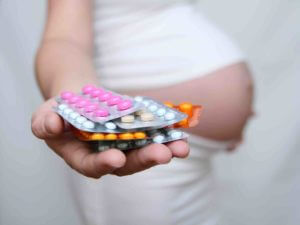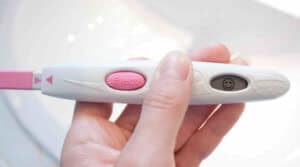Within a cycle, women can recognize infertile and fertile days. Whether you favor a pregnancy or even avoid it is up to you. Nevertheless, there are various ways and tools with which you can recognize these phases.
How you can recognize or calculate your fertile days, you will learn here.
Table of contents
Calculate Fertile Days And Get Pregnant Easily
You and your partner want to have a baby? Many couples simply start trying after deciding to have a child. But did you know that you can help your happiness in a natural way?
Basically, here’s the deal: a woman can actually only get pregnant five to six days into her cycle. After ovulation, an egg is de facto only capable of fertilization for up to 18 hours afterwards.
The symptothermal method makes use of exactly these circumstances in two areas of application. With this method and the calculation of your fertile phases you can set the course for your desire to have a child or for your contraception.
On average, a woman’s cycle lasts between 23 and 35 days. It really is a miracle to get pregnant right away without knowing your own fertile phases when you want to have a child. For many women, it is not easy to get pregnant.
However, if you know your fertile days, you can drastically increase the chances of fertilization. Especially if you and your partner are trying unsuccessfully to have a child.
The symptothermal method can be very helpful in this case. You specifically use fertile days in your cycle. This is not a guarantee of pregnancy, but it increases the chances of natural conception.
If you have already been working on pregnancy for about a year or more – without success and considering your most fertile phases – it is advisable to talk to a doctor. Your partner should then also have a medical examination.

Detecting Fertile Days With The Symptothermal Method
You may ask yourself: How can I recognize fertile days with this method? Can I calculate my awful periods relatively accurately? The answer is: Yes!
In a nutshell: You measure your body temperature every morning before getting up. In addition, you look at your cervical mucus every day of your cycle and determine its quality. These two factors, when combined, provide a fairly reliable method of identifying infertile and fertile days.
All measurements are aimed at determining the time of your ovulation and the immediate period around it. The more body signals you include in these measurements, such as the condition of your cervix, your cervix, the appearance of your skin, or your libido, the more accurately you can determine the period of your ovulation.
Over time, you will be able to recognize a pattern in your cycle that repeats almost identically every month and reveals your most fertile time in the cycle.
But this method is not self-propelling and can be learned quickly. It takes practice and patience until you understand the signs of your body, can classify them, and correctly put them in relation to other factors.
However, as soon as you understand the symptothermal method correctly and apply it consistently, you will be able to use natural contraception in the future or use fertile days and plan a pregnancy better.
Desire For A Child Vs. Contraception
The symptothermal method is also a quite safe way of contraception. Used consistently and correctly, it has a Pearl Index (a measure of contraceptive safety and reliability) of about 0.4, which is roughly equivalent to that of the hormone contraceptive, the Pill.
Couples who do not wish to have children simply use the method in reverse. This means that they use the woman’s infertile days for unprotected sex. Infertile phases, they then do not have sexual intercourse or use other means of contraception, such as the condom or diaphragm.
Of course, this Pearl Index is only valid for women or couples who use the method consistently in their applicable rules. In everyday life, this type of contraception therefore has a value of 1.8 in the safety-in-use study.
In principle, the safety is subject to the correct use and the consistency of the user, similar to the use of the pill or other contraceptives.
If, on the other hand, you and your partner would like to have a baby, you can use the symptothermal method to target your fertile phases for family planning. Knowing that you can only get pregnant during a certain period, you can approach your baby planning in a much more relaxed way.
Within your fertile time it is not necessary to have sex several times a day. Wondering how long sperm life is? Sperm can survive in the vagina for five days during your fertile period.
This means in the example: If you have sex around two to four days before your ovulation, the sperm survive long enough to make fertilization possible.
For Whom Is The Symptothermal Method Worthwhile?
Of course, every contraceptive method or fertilization option has advantages and disadvantages. As already mentioned, the symptothermal method requires practice, experience and patience.
It takes about three to six months until you can recognize a regularity in your cycle and determine and calculate fertile days with certainty. Therefore, it is important that you intensively deal with the topic in advance.
Only you can answer the question in the course of this: Is this method right for you? Many women who use the symptothermal method to conceive or use it for contraception swear by it. To give you a rough overview, here are some pros and cons:
Pros:
- Hormone-free.
- Better body feeling.
- Can also be used during shift work.
- High reliability.
- Can be used for both contraception and childbearing.
- Inexpensive.
Contra:
- Consistency necessary.
- Only the 2-factor measurement (cervical mucus AND temperature) provides safety.
- High index of 1.8 in the safety of use study.
- Long acclimatization period.
- Does not protect against diseases.
What Is The Role Of Body Temperature?
In the use of the symptothermal method and to be able to recognize your fertile days, the focus is on your body. You have to look closely and get to know your body. Many women report a new self-confidence and a stronger trust in their body.
The first step is to measure and evaluate your body temperature. Your body temperature is one of two essential characteristics that you must always and regularly measure with the symptothermal method.
First of all, your body temperature is divided into two phases during your cycle. The low phase and the high phase. In the period before ovulation you will find lower temperature values when measuring.
Around your ovulation, it will rise by at least 0.2°C. This temperature rise in the so-called high position marks the time after ovulation and thus the second half of the cycle.
What Triggers The Temperature Rise?
In this second half of the cycle, after ovulation, the hormone progesterone is formed. Progesterone in turn has an effect on the body’s thermoregulation and thus raises your temperature. This hormone is only formed after previous ovulation, which is why a temperature increase always takes place afterward.
Women often confuse the timing and assume that a sudden increase in temperature marks the actual day of ovulation. This is not correct. Only ovulation triggers this increased temperature. In the symptothermal method, this is called the first higher measurement (1st hM).
What Is Basal Body Temperature And How Do You Measure It?
Basal body temperature is your waking temperature. This temperature describes your body temperature after at least one hour of sleep and complete rest. Only this temperature can be evaluated in the symptothermal method. In order to obtain comparable measurement results, it is important to always measure at the same time.
Your circulation and body temperature fluctuate throughout the day when you are awake and active. This can falsify the measurement and evaluation.
You measure your basal body temperature directly after waking up. You can do this orally, vaginally, and rectally. As soon as you decide on a measuring method, you should stick to it for this period of this cycle. In the next cycle, you can change if necessary. You can use an analog or digital thermometer for measuring.
With digital thermometers it is important to have a two-digit display after the decimal point. With the symptothermal method, the values after the decimal point are particularly important in the evaluation. You can find more information about basal body temperature here.
Other Ways To Detect Fertile Days
There are now many different apps, websites or service providers that help you to use the symptothermal method, evaluate it correctly and calculate fertile phases.
Some women document their cycles and fertile days with NFP, use literature such as “Naturally and Safely” or make use of ovulation tests and strips for additional security.
The brands femSense or AVA partly use knowledge of the symptothermal method and also calculate fertile days with the help of a patch including a sensor or a sensor bracelet.
Cervical Mucus – Does It Play A Role?
Definitely! Fertile days can only be detected in combination with cervical mucus. It’s amazing how much you learn about your body and your fertility by looking at it. Especially the observation over a long period of time gives a lot of information.
You may notice discharge or mucus from time to time, but you haven’t paid much attention to it. In the application of the symptothermal method, it is necessary to look at and categorize the cervical mucus every day.
This is because of the appearance of the mucus changes during your cycle. Both the color and consistency give you information about where you are in your cycle. Cervical mucus is, among other things:
- Tough.
- Liquid, like egg white.
- Yellowish.
- Whitish.
- Cloudy.
- Reddish brown.
- Sticky.
- Creamy.
In the symptothermal method, both color and consistency play a major role in identifying the most fertile phase of your cycle. This involves categorizing the mucus. In many women, for example, the cervical mucus is clear and transparent shortly before ovulation. In infertile phases, on the other hand, it is creamy or viscous.
This has to do, among other things, with the fact that the mucus is a transporter or blockage for sperm. The more fertile you are, the better the quality of mucus. The better it is, the better the environment and survival conditions for sperm in your vagina.
Recognizing And Interpreting Differences Correctly
If you are starting with the symptothermal method and have never paid attention to the appearance of your cervical mucus until now, it may take a while to know how to categorize which mucus and when. Calculating and recognizing the fertile phase will still be a challenge.
However, online you can find many sites or forums that deal with this topic and help you. In addition, you must not forget that every woman is individual and so is everybody. This can mean that the mucus of an apparently inferior quality in you, in another woman is already the best quality that her body produces.
This in no way diminishes your or her fertility. It just means that everybody works differently. The same is true for temperature. Over time, you will get a sense of what your regular basal body temperature is at the beginning, middle, and end of your cycle. This is also different for every woman.
What To Do If You Have An Irregular Cycle
Do you suffer from an irregular cycle? Are you unsure whether you can calculate your fertile phase at all? By documenting your cycles, you may be able to find out why your cycle is irregular.
If your cycle is shorter or longer than 23 to 35 days, if your bleeding lasts longer than eight days, or if you don’t have a measurable increase in temperature, you should see a doctor.
Give The Method A Chance
The proof of the pudding is in the eating. So if you like to recognize and calculate fertile days with the symptothermal method, you need patience and have to observe your cycle closely. But you will be rewarded. You will get to know your body in a new way and you will be able to better interpret correlations in terms of performance, moods, or complaints.













3 thoughts on “Get Pregnant Naturally: Recognize The Fertile Days”